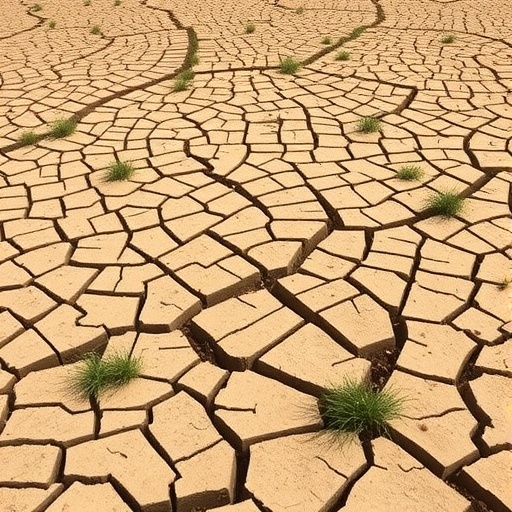A groundbreaking international research initiative spearheaded by Colorado State University has unveiled the severe repercussions of prolonged and extreme drought conditions on grassland and shrubland ecosystems worldwide. These ecosystems, spanning nearly half of the Earth’s terrestrial surface, are vital for carbon sequestration, biodiversity, and agricultural productivity. The study, set to appear in Science on October 16, 2025, meticulously demonstrates that drought intensity combined with duration can dramatically exacerbate losses in plant primary productivity, challenging existing assumptions about ecosystem resilience amid climate stressors.
The research emerged from the International Drought Experiment, a coordinated global effort involving over 170 scientists from six continents. Using innovative rainfall exclusion infrastructures designed to simulate rare 1-in-100-year droughts, the team reduced precipitation across diverse grassland and shrubland sites for four consecutive years. This unprecedented manipulation allowed for a detailed examination of ecosystem responses not only to drought severity but also to the persistence of dry conditions, an aspect often overlooked in shorter-term drought studies.
Results from the experiment revealed that the cumulative impact of extreme multi-year droughts is far more detrimental than previously recognized. Plant productivity losses exceeded twice those observed under moderate drought scenarios of similar duration. The data expose a concerning trend toward diminished recovery ability in these ecosystems, with prolonged water deficits driving irreversible declines in biomass production and photosynthetic capacity over time.
Colorado State University Biology Professor Melinda Smith, who led the study, highlights the critical interplay between drought intensity and duration in shaping ecosystem vulnerability. “Our findings emphasize that consecutive years of severe drought amplify the stress on these vegetation communities beyond what a single extreme drought or moderate prolonged drought can induce,” Smith explains. This interaction mirrors historical events such as the 1930s Dust Bowl, where persistent dry conditions led to catastrophic soil erosion and widespread ecological collapse.
The global significance of this research lies in its direct relevance to climate change projections, which forecast increased frequency and severity of drought episodes in many grassland and shrubland regions. These ecosystems serve as major carbon sinks, storing more than 30% of global terrestrial carbon in vegetation and soils. Alterations in their productivity dynamics therefore have profound implications for the global carbon cycle and atmospheric CO2 regulation.
The multi-site experimental design was crucial for accounting for the variability in precipitation regimes, soil types, and species compositions across continents. This diversity provided a robust framework to disentangle how differing environmental contexts influence drought impact trajectories. Consequently, the findings extend beyond localized case studies to offer a comprehensive understanding applicable at biome and planetary scales.
Plant growth underpins the sequestration of atmospheric carbon through photosynthesis, making it a fundamental driver of terrestrial ecosystem function. By quantifying the amplified productivity losses under compounded drought scenarios, this study elucidates feedback mechanisms that could accelerate climate warming through reduced carbon uptake capacity. The resultant feedback could exacerbate the frequency of extreme drought events, initiating a potentially self-reinforcing cycle detrimental to ecosystem stability.
Among the study collaborators were prominent researchers from Colorado State University’s Biology Department, including Professors Alan Knapp and Eugene Kelly, Associate Professor Daniela Cusack, and Research Associate Anping Chen. Their expertise in ecosystem ecology and climate interactions contributed to comprehensive data analysis spanning various global grassland environments. Contributions from early-career scientists further enriched methodological innovation and interpretation.
Prior research from this consortium has already established the immediate effects of short-term, extreme drought on these ecosystems, detailed in a preceding PNAS publication. The current Science paper builds on this foundation by integrating an extended temporal dimension, highlighting that ecosystem responses evolve nonlinearly with repeated and prolonged water stress. This progression underscores the need for re-evaluating ecosystem vulnerability models to incorporate temporal dynamics.
The implications of this study extend beyond ecological theory into practical realms such as agriculture, land management, and climate policy. Grasslands and shrublands support vital industries including livestock production, which may face novel challenges due to decreased forage availability and increased ecosystem degradation under intensifying drought regimes. Understanding these risks is paramount for developing adaptive strategies to sustain ecosystem services in a warming world.
In summary, the International Drought Experiment offers a transformative insight into how extreme drought intensity compounded by duration profoundly diminishes grassland and shrubland productivity globally. This research articulates a clear warning pulse for the future of terrestrial ecosystems under climate change, emphasizing the urgency to refine global carbon cycle models and prioritize ecosystem resilience research. As climate patterns shift, the specter of Dust Bowl-scale events could become an increasingly common reality, necessitating concerted global scientific and policy attention.
Subject of Research: Effects of prolonged extreme drought on grassland and shrubland ecosystem productivity and resilience.
Article Title: Drought intensity and duration interact to magnify losses in primary productivity
News Publication Date: 16-Oct-2025
Web References:
DOI Link
Image Credits:
Credit: Colorado State University College of Natural Sciences
Keywords:
Drought, Grasslands, Shrublands, Primary Productivity, Climate Change, Carbon Sequestration, Ecosystem Resilience, Photosynthesis, International Drought Experiment, Carbon Cycle, Soil Erosion, Extreme Weather




